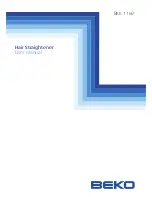
34
EN
35
Laundry tag
Type of fabric
Temperature control
Chemical fibres
e.g. polyester, viscose
•
low temperature
Silk, wool
••
medium temperature
Cotton, flax
•••
high temperature
Fabrics which can not be ironed
We recommend ironing fabrics with uncommon surfaces (e.g. filters, embroidery, printings etc.) at the lowest
temperature.
As far as mixes are concerned (e.g. 40% cotton, 60% synthetic material), set the temperature control according
to the fabric requiring the lower temperature.
If you are not sure of the fabric composition, determine the suitable temperature by performing a test on
the least noticeable part of clothing. Begin with the lowest temperature and slowly increase until the ideal
temperature is achieved.
Never iron spots with traces of perspiration etc.: heat from the iron fixates fabric stains which cannot be
removed.
Removing grease stains is more effect using a dry iron at medium temperature: excessive heat burns the
grease and could result in the formation of yellow stains.
Iron silk, wool and synthetic fabrics inside out to prevent shiny stains from appearing.
Iron velvet fabrics in one direction (in the direction of fibres) and do not press on the iron to prevent shiny
stains from appearing.
The more laundry put into the washing machine, the more wrinkled the laundry will be. Laundry will also
wrinkle more during high speed centrifugation.
Many fabrics are easier to iron if not completely dry. For example, silk should always be ironed moist.
Use the temperature control to set the ironing temperature according to the type of fabric (fig. 3). A lit
indicator signals the heat-up process of the soleplate. The indicator light going out signals the required
temperature has been reached and the ironing process can begin.
The plate temperature indicator occasionally lights up when ironing, indicating the temperature setting
is maintained. After finishing your ironing at a high temperature and reducing the temperature, do not
continue using the iron until the soleplate temperature indicator lights up again.
Note:
Since the cooling process takes longer than warm-up, we recommend ironing fabrics requiring lower
temperatures first. This way you eliminate the risk of burning the fabric.
IRONING AND THE STEAM FUNCTION
Ironing without steam
For steamless ironing, set the steam control to “0” (pic. 1) and set the temperature according to the type of
fabric.
Ironing with steam
Steam ironing requires setting the temperature to position ••. The amount of steam can be set using the
steam control. Setting the temperature to ••• is recommended for using the maximum amount of steam.
Ironing with the steam burst
Press steam shot for ironing hard to remove creases slowly (dense spray) or quickly (fine spray) (pic. 6).
Содержание NZ 221
Страница 2: ......
Страница 7: ...CZ 7 ...
Страница 13: ...SK 13 ...
Страница 19: ...PL 19 ...
Страница 25: ...HU 25 ...
Страница 31: ...DE 31 ...
Страница 37: ...EN 37 ...
Страница 39: ......






































